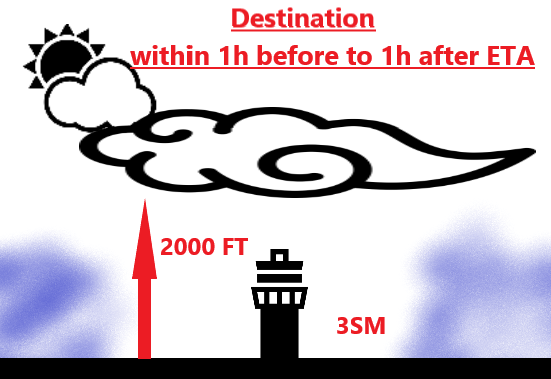どうも。あざらしです。今回はIFRでの飛行条件と、フライトプランについて記載します。
IFRで飛行する際の燃油積載条件 § 91.167
※ Fuel requirements for flight in IFR conditions.
IFRでフライトする上で必要な燃油量は下記の通りです。
必要な燃油量 = 出発空港から目的地空港までの必要燃油量 + 目的地空港から代替空港までの燃油量 + 45分 normal cruising speed で飛行した際の燃油量

フライトプランについて§ 91.169
いつ:IFRの状況下でControl airspaceに進入する前までに、管制担当官から許可を得る必要があります。
どうやって:フライトプラン提出方法は3つ。FSSへ電話をする。ATCに離陸前にRadioで連絡。Foreflightや1800wxbf等のネットを使用する。
代替空港が必要か否かの判断(Flight planへ記入要否)§ 91.169
到着空港の気象条件次第で、代替空港が必要か否かが変わります。
いつ:到着予定時刻の1時間前後で
どのような:気象予報が「Ceilingが2000FT以下」「3SMの視程以下」であった場合

代替空港の気象条件§ 91.169
Precision approach(例:ILS) :Ceiling 600FT + 2SM VIS
Non precision approach (例:RNAV、VORなど) :Ceiling 800FT + 2SM VIS
No Instrument approach(計器進入の設定がない空港の場合):MEAで飛行し、VFR条件でApproachし着陸しなければなりません。
注釈:空港によって「Alternate minimums」という、上記とは異なる最低条件がある場合があります。Approach plateの左上に「三角形内にA」と記載されたものが、この最低条件があるという意味です。詳細は「U.S.Terminal Procedures Publication」に記載されております。FAAホームページから無料でダウンロードできますのでご確認ください。
https://www.faa.gov/air_traffic/flight_info/aeronav/digital_products/dtpp/

条文
§ 91.167 Fuel requirements for flight in IFR conditions.
(a) No person may operate a civil aircraft in IFR conditions unless it carries enough fuel (considering weather reports and forecasts and weather conditions) to -
(1) Complete the flight to the first airport of intended landing;
(2) Except as provided in paragraph (b) of this section, fly from that airport to the alternate airport; and
(3) Fly after that for 45 minutes at normal cruising speed or, for helicopters, fly after that for 30 minutes at normal cruising speed.
(b) Paragraph (a)(2) of this section does not apply if:
(1) Part 97 of this chapter prescribes a standard instrument approach procedure to, or a special instrument approach procedure has been issued by the Administrator to the operator for, the first airport of intended landing; and
(2) Appropriate weather reports or weather forecasts, or a combination of them, indicate the following:
(i) For aircraft other than helicopters. For at least 1 hour before and for 1 hour after the estimated time of arrival, the ceiling will be at least 2,000 feet above the airport elevation and the visibility will be at least 3 statute miles.
(ii) For helicopters. At the estimated time of arrival and for 1 hour after the estimated time of arrival, the ceiling will be at least 1,000 feet above the airport elevation, or at least 400 feet above the lowest applicable approach minima, whichever is higher, and the visibility will be at least 2 statute miles.
§ 91.169
IFR flight plan: Information required.
(a) Information required. Unless otherwise authorized by ATC, each person filing an IFR flight plan must include in it the following information:
(1) Information required under Sec. 91.153 (a) of this part;
(2) Except as provided in paragraph (b) of this section, an alternate airport.
(b) Paragraph (a)(2) of this section does not apply if :
(1) Part 97 of this chapter prescribes a standard instrument approach procedure to, or a special instrument approach procedure has been issued by the Administrator to the operator for, the first airport of intended landing; and
(2) Appropriate weather reports or weather forecasts, or a combination of them, indicate the following:
(i) For aircraft other than helicopters. For at least 1 hour before and for 1 hour after the estimated time of arrival, the ceiling will be at least 2,000 feet above the airport elevation and the visibility will be at least 3 statute miles.
(ii) For helicopters. At the estimated time of arrival and for 1 hour after the estimated time of arrival, the ceiling will be at least 1,000 feet above the airport elevation, or at least 400 feet above the lowest applicable approach minima, whichever is higher, and the visibility will be at least 2 statute miles.
(c) IFR alternate airport weather minima. Unless otherwise authorized by the Administrator, no person may include an alternate airport in an IFR flight plan unless appropriate weather reports or weather forecasts, or a combination of them, indicate that, at the estimated time of arrival at the alternate airport, the ceiling and visibility at that airport will be at or above the following weather minima:
(1) If an instrument approach procedure has been published in part 97 of this chapter, or a special instrument approach procedure has been issued by the Administrator to the operator, for that airport, the following minima:
(i) For aircraft other than helicopters: The alternate airport minima specified in that procedure, or if none are specified the following standard approach minima:
(A) For a precision approach procedure. Ceiling 600 feet and visibility 2 statute miles.
(B) For a nonprecision approach procedure. Ceiling 800 feet and visibility 2 statute miles.
(ii) For helicopters: Ceiling 200 feet above the minimum for the approach to be flown, and visibility at least 1 statute mile but never less than the minimum visibility for the approach to be flown, and
(2) If no instrument approach procedure has been published in part 97 of this chapter and no special instrument approach procedure has been issued by the Administrator to the operator, for the alternate airport, the ceiling and visibility minima are those allowing descent from the MEA, approach, and landing under basic VFR.
(d) Cancellation. When a flight plan has been activated, the pilot in command, upon canceling or completing the flight under the flight plan, shall notify an FAA Flight Service Station or ATC facility.
以上
最後までお付き合いいただきありがとうございました。

